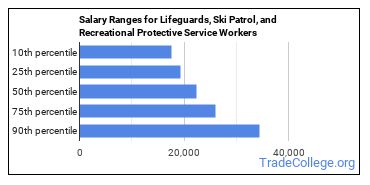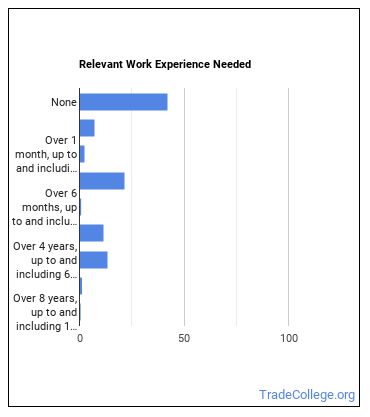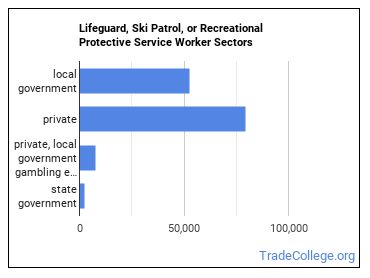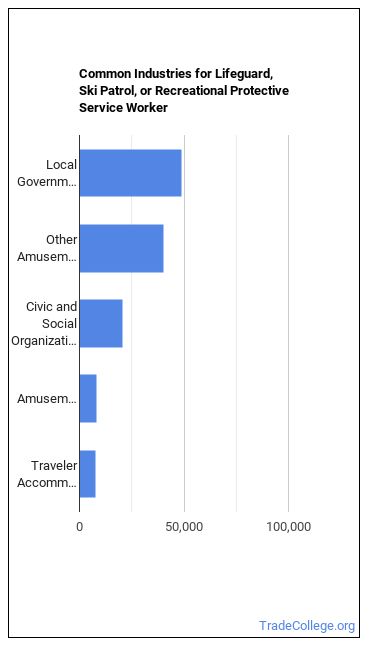What Do Lifeguard, Ski Patrol, or Recreational Protective Service Worker Do?
Occupation Description Monitor recreational areas, such as pools, beaches, or ski slopes to provide assistance and protection to participants.
Lifeguard, Ski Patrol, or Recreational Protective Service Worker Responsibilities
- Warn recreational participants of inclement weather, unsafe areas, or illegal conduct.
- Maintain quality of pool water by testing chemical levels.
- Patrol or monitor recreational areas such as trails, slopes, or swimming areas, on foot, in vehicles, or from towers.
- Provide assistance with staff selection, training, and supervision.
- Observe activities in assigned areas, using binoculars, to detect hazards, disturbances, or safety infractions.
- Contact emergency medical personnel in case of serious injury.
Featured schools near , edit
What Every Lifeguard, Ski Patrol, or Recreational Protective Service Worker Should Know
When polled, Lifeguards, Ski Patrol, and Recreational Protective Service Workers say the following skills are most frequently used in their jobs:
Speaking: Talking to others to convey information effectively.
Monitoring: Monitoring/Assessing performance of yourself, other individuals, or organizations to make improvements or take corrective action.
Active Listening: Giving full attention to what other people are saying, taking time to understand the points being made, asking questions as appropriate, and not interrupting at inappropriate times.
Service Orientation: Actively looking for ways to help people.
Judgment and Decision Making: Considering the relative costs and benefits of potential actions to choose the most appropriate one.
Critical Thinking: Using logic and reasoning to identify the strengths and weaknesses of alternative solutions, conclusions or approaches to problems.
Related Job Titles for this Occupation:
- Rescue Worker
- Ranger
- Ski Patrol
- Water Safety Instructor (WSI)
- Recreation Director
Lifeguard, Ski Patrol, or Recreational Protective Service Worker Employment Estimates
In the United States, there were 152,100 jobs for Lifeguard, Ski Patrol, or Recreational Protective Service Worker in 2016. New jobs are being produced at a rate of 7.6% which is above the national average. The Bureau of Labor Statistics predicts 11,600 new jobs for Lifeguard, Ski Patrol, or Recreational Protective Service Worker by 2026. The BLS estimates 39,700 yearly job openings in this field.

The states with the most job growth for Lifeguard, Ski Patrol, or Recreational Protective Service Worker are Utah, Colorado, and New Jersey. Watch out if you plan on working in Maine, Rhode Island, or West Virginia. These states have the worst job growth for this type of profession.
How Much Does a Lifeguard, Ski Patrol, or Recreational Protective Service Worker Make?
The average yearly salary of a Lifeguard, Ski Patrol, or Recreational Protective Service Worker ranges between $17,560 and $34,400.

Lifeguards, Ski Patrol, and Recreational Protective Service Workers who work in Hawaii, District of Columbia, or Alaska, make the highest salaries.
How much do Lifeguards, Ski Patrol, and Recreational Protective Service Workers make in each U.S. state?
| State | Annual Mean Salary |
|---|---|
| Alabama | $19,300 |
| Alaska | $37,510 |
| Arizona | $24,770 |
| Arkansas | $20,360 |
| California | $34,430 |
| Colorado | $25,330 |
| Connecticut | $25,520 |
| Delaware | $22,820 |
| District of Columbia | $36,810 |
| Florida | $26,690 |
| Georgia | $20,660 |
| Hawaii | $40,370 |
| Idaho | $19,870 |
| Illinois | $24,220 |
| Indiana | $19,900 |
| Iowa | $20,330 |
| Kansas | $19,560 |
| Kentucky | $19,620 |
| Louisiana | $19,670 |
| Maine | $23,460 |
| Maryland | $22,650 |
| Massachusetts | $27,940 |
| Michigan | $25,160 |
| Minnesota | $25,260 |
| Mississippi | $19,840 |
| Missouri | $19,280 |
| Montana | $21,200 |
| Nebraska | $21,760 |
| Nevada | $22,460 |
| New Hampshire | $24,820 |
| New Jersey | $25,620 |
| New Mexico | $20,890 |
| New York | $27,630 |
| North Carolina | $20,210 |
| North Dakota | $25,030 |
| Ohio | $20,570 |
| Oklahoma | $19,260 |
| Oregon | $24,510 |
| Pennsylvania | $20,320 |
| Rhode Island | $25,360 |
| South Carolina | $21,090 |
| South Dakota | $22,150 |
| Tennessee | $20,320 |
| Texas | $21,450 |
| Utah | $21,500 |
| Vermont | $25,760 |
| Virginia | $23,180 |
| Washington | $29,120 |
| West Virginia | $21,270 |
| Wisconsin | $20,810 |
| Wyoming | $26,560 |
What Tools do Lifeguards, Ski Patrol, and Recreational Protective Service Workers Use?
Although they’re not necessarily needed for all jobs, the following technologies are used by many Lifeguards, Ski Patrol, and Recreational Protective Service Workers:
- Microsoft Excel
- Microsoft Word
- Microsoft PowerPoint
- Microsoft Outlook
- Microsoft Publisher
How do I Become a Lifeguard, Ski Patrol, or Recreational Protective Service Worker?
Individuals working as a Lifeguard, Ski Patrol, or Recreational Protective Service Worker have obtained the following education levels:

What work experience do I need to become a Lifeguard, Ski Patrol, or Recreational Protective Service Worker?

Lifeguards, Ski Patrol, and Recreational Protective Service Workers Sector

Lifeguards, Ski Patrol, and Recreational Protective Service Workers work in the following industries:

You May Also Be Interested In…
Career changers with experience as a Lifeguard, Ski Patrol, or Recreational Protective Service Worker sometimes find work in one of the following fields:
References:
Image Credit: Brian M. Powell via Attribution-ShareAlike 3.0 Unported (CC BY-SA 3.0)
More about our data sources and methodologies.
Featured Schools
 Request Info
Request Info
|
Southern New Hampshire University You have goals. Southern New Hampshire University can help you get there. Whether you need a bachelor's degree to get into a career or want a master's degree to move up in your current career, SNHU has an online program for you. Find your degree from over 200 online programs. Learn More > |
